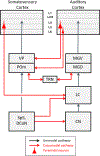Role of auditory-somatosensory corticothalamic circuit integration in analgesia
- PMID: 36931195
- PMCID: PMC10755628
- DOI: 10.1016/j.ceca.2023.102717
Role of auditory-somatosensory corticothalamic circuit integration in analgesia
Abstract
Our sensory environment is permeated by a diverse array of auditory and somatosensory stimuli. The pairing of acoustic signals with concurrent or forthcoming tactile cues are abundant in everyday life and various survival contexts across species, thus deeming the ability to integrate sensory inputs arising from the combination of these stimuli as crucial. The corticothalamic system plays a critical role in orchestrating the construction, integration and distribution of the information extracted from these sensory modalities. In this mini-review, we provide a circuit-level description of the auditory corticothalamic pathway in conjunction with adjacent corticothalamic somatosensory projections. Although the extent of the functional interactions shared by these pathways is not entirely elucidated, activation of each of these systems appears to modulate sensory perception in the complementary domain. Several specific issues are reviewed. Under certain environmental noise conditions, the spectral information of a sound could induce modulations in nociception and even induce analgesia. We begin by discussing recent findings by Zhou et al. (2022) implicating the corticothalamic system in mediating sound-induced analgesia. Next, we describe relevant components of the corticothalamic pathway's functional organization. Additionally, we describe an emerging body of literature pointing to intrathalamic circuitry being optimal for controlling and selecting sensory signals across modalities, with the thalamic reticular nucleus being a candidate mechanism for directing cross-modal interactions. Finally, Ca2+ bursting in thalamic neurons evoked by the thalamic reticular nucleus is explored.
Keywords: Auditory-somatosensory integration; Corticothalamic circuits; Sound-induced analgesia; Thalamic Ca(2+) bursting.
Copyright © 2023 Elsevier Ltd. All rights reserved.
Conflict of interest statement
Declaration of Competing Interest None
Figures

References
-
- Kelly JP, Wong D, Laminar connections of the cat’s auditory cortex, Brain Res, 212 (1981) 1–15. - PubMed
-
- Winer JA, Diehl JJ, Larue DT, Projections of auditory cortex to the medial geniculate body of the cat, J Comp Neurol, 430 (2001) 27–55. - PubMed
-
- Harris JA, Mihalas S, Hirokawa KE, Whitesell JD, Choi H, Bernard A, Bohn P, Caldejon S, Casal L, Cho A, Feiner A, Feng D, Gaudreault N, Gerfen CR, Graddis N, Groblewski PA, Henry AM, Ho A, Howard R, Knox JE, Kuan L, Kuang X, Lecoq J, Lesnar P, Li Y, Luviano J, McConoughey S, Mortrud MT, Naeemi M, Ng L, Oh SW, Ouellette B, Shen E, Sorensen SA, Wakeman W, Wang Q, Wang Y, Williford A, Phillips JW, Jones AR, Koch C, Zeng H, Hierarchical organization of cortical and thalamic connectivity, Nature, 575 (2019) 195–202. - PMC - PubMed
Publication types
MeSH terms
Grants and funding
LinkOut - more resources
Full Text Sources
Miscellaneous

